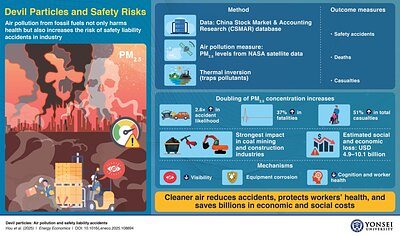
Air Pollution Linked to Surge in Workplace Accidents, New Study Reveals
A groundbreaking study links rising PM2.5 levels to a significant increase in workplace accidents, fatalities, and economic losses, prompting calls for integrated safety and environmental policies.
Air Pollution Linked to Surge in Workplace Accidents, New Study Reveals
Seoul, South Korea – November 1, 2025 – Air pollution isn’t just a public health crisis; it’s a serious – and often overlooked – workplace safety hazard. A new study from Yonsei University has established a compelling link between fine particulate matter (PM2.5) and a surge in workplace accidents, fatalities, and substantial economic losses. The research, published in Energy Economics, underscores the urgent need for integrated environmental and occupational safety policies to protect workers and bolster industrial resilience.
Researchers analyzed two decades of accident data from China, a nation grappling with significant air pollution challenges, and found that doubling PM2.5 concentrations is associated with a 2.6-fold increase in workplace accident risk. The study further revealed a 37% increase in fatalities and a 51% rise in total casualties – demonstrating the devastating human cost of polluted air in industrial settings. The economic impact is estimated to be between $4.9 billion and $10.1 billion annually.
“Our findings highlight a critical, previously underestimated dimension of air pollution’s societal burden,” explained Dr. Ning Zhang, lead author of the study. “It’s no longer sufficient to consider air quality solely as a health issue; we must recognize its direct impact on workplace safety and economic stability.”
Beyond Health: The Industrial Impact of PM2.5
The link between air pollution and respiratory illnesses is well-documented. However, this study delves deeper, revealing how PM2.5 affects cognitive function, reaction times, and overall worker performance – factors critical in high-risk industries like mining, construction, and manufacturing.
“The cognitive impact is significant,” says an environmental economist familiar with the study’s methodology. “Even subtle decreases in cognitive function can lead to errors in judgment and slower reaction times, drastically increasing the risk of accidents in demanding work environments.”
The study's findings resonate with mounting evidence that PM2.5 affects not just the lungs but the brain. Reduced cognitive function compromises worker alertness, spatial awareness, and decision-making abilities – all essential for operating machinery, navigating hazardous environments, and adhering to safety protocols.
A Risk Multiplier in High-Risk Sectors
The study’s findings are particularly concerning for industries already facing inherent safety challenges. Mining, for example, involves operating heavy machinery in confined spaces, navigating unstable terrain, and exposure to hazardous materials. Air pollution acts as a risk multiplier, exacerbating these existing dangers.
“In the mining sector, even a small reduction in cognitive function can have catastrophic consequences,” notes a safety consultant specializing in the industry. “Operators may misjudge distances, fail to notice critical warning signs, or react slower to emergency situations, leading to serious accidents.”
The construction sector, with its constant movement of personnel and equipment, also faces heightened risks. Poor visibility due to air pollution, coupled with compromised worker alertness, creates a dangerous combination.
Policy Gaps and the Need for Integration
While China has made strides in improving air quality in recent years, the study reveals significant policy gaps in addressing the intersection of environmental and occupational safety. Current workplace safety regulations often lack specific provisions for mitigating the risks of air pollution.
“There’s a disconnect between environmental regulations and workplace safety standards,” says an environmental lawyer specializing in industrial compliance. “Current regulations focus primarily on emissions control, but they don't adequately address the impact of pollution on worker health and safety.”
Experts recommend a more integrated approach, combining stricter air quality standards with comprehensive workplace safety protocols. This includes implementing real-time air quality monitoring systems in industrial settings, providing workers with appropriate respiratory protection, and establishing clear guidelines for suspending operations during periods of high pollution.
Technological Solutions and Preventative Measures
Beyond regulatory changes, technological solutions can play a vital role in mitigating the risks of air pollution in the workplace. Advanced air purification systems can remove PM2.5 from indoor environments, creating safer working conditions. Real-time air quality monitoring systems can provide early warnings of pollution spikes, allowing employers to take preventative measures, such as suspending outdoor operations or adjusting work schedules.
“Investing in air purification technology and monitoring systems is not just a matter of worker safety; it’s a smart business decision,” says a sustainability consultant specializing in industrial solutions. “Reducing worker exposure to pollution can improve productivity, reduce healthcare costs, and minimize legal liabilities.”
However, technology alone is not enough. Effective worker training and awareness programs are crucial to ensure that employees understand the risks of air pollution and know how to protect themselves. This includes providing clear guidelines for using respiratory protection, recognizing the symptoms of exposure, and reporting potential hazards.
Looking Ahead
The Yonsei University study serves as a wake-up call for policymakers, industry leaders, and workers alike. Addressing the impact of air pollution on workplace safety requires a multifaceted approach, combining stricter regulations, technological innovation, and comprehensive worker training. Ignoring this issue not only puts workers at risk but also undermines industrial productivity and economic stability.
“We need to move beyond the traditional siloed approach to environmental and occupational safety,” emphasizes Dr. Zhang. “Protecting workers from the harmful effects of air pollution is not just a matter of compliance; it’s a matter of social responsibility and economic sustainability.”
